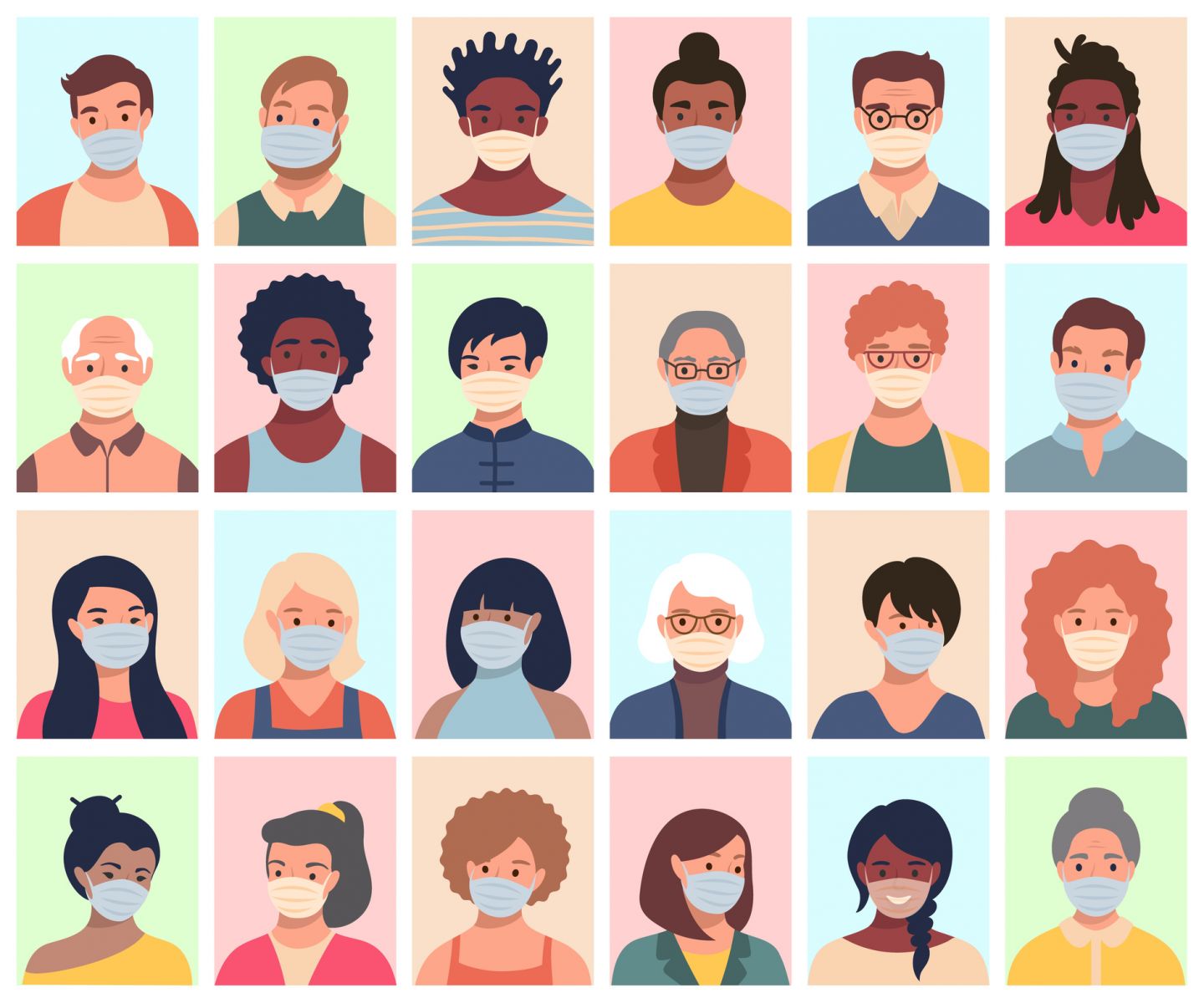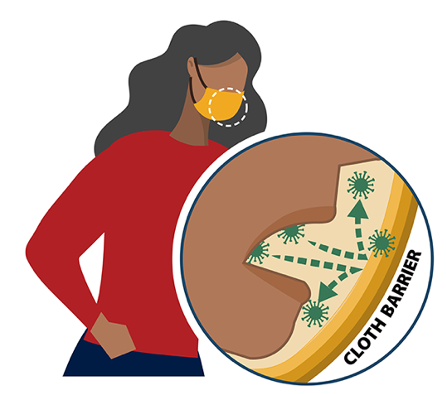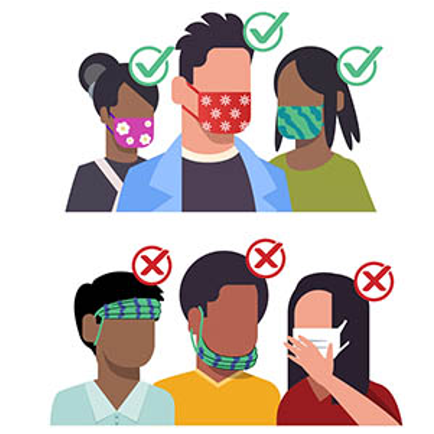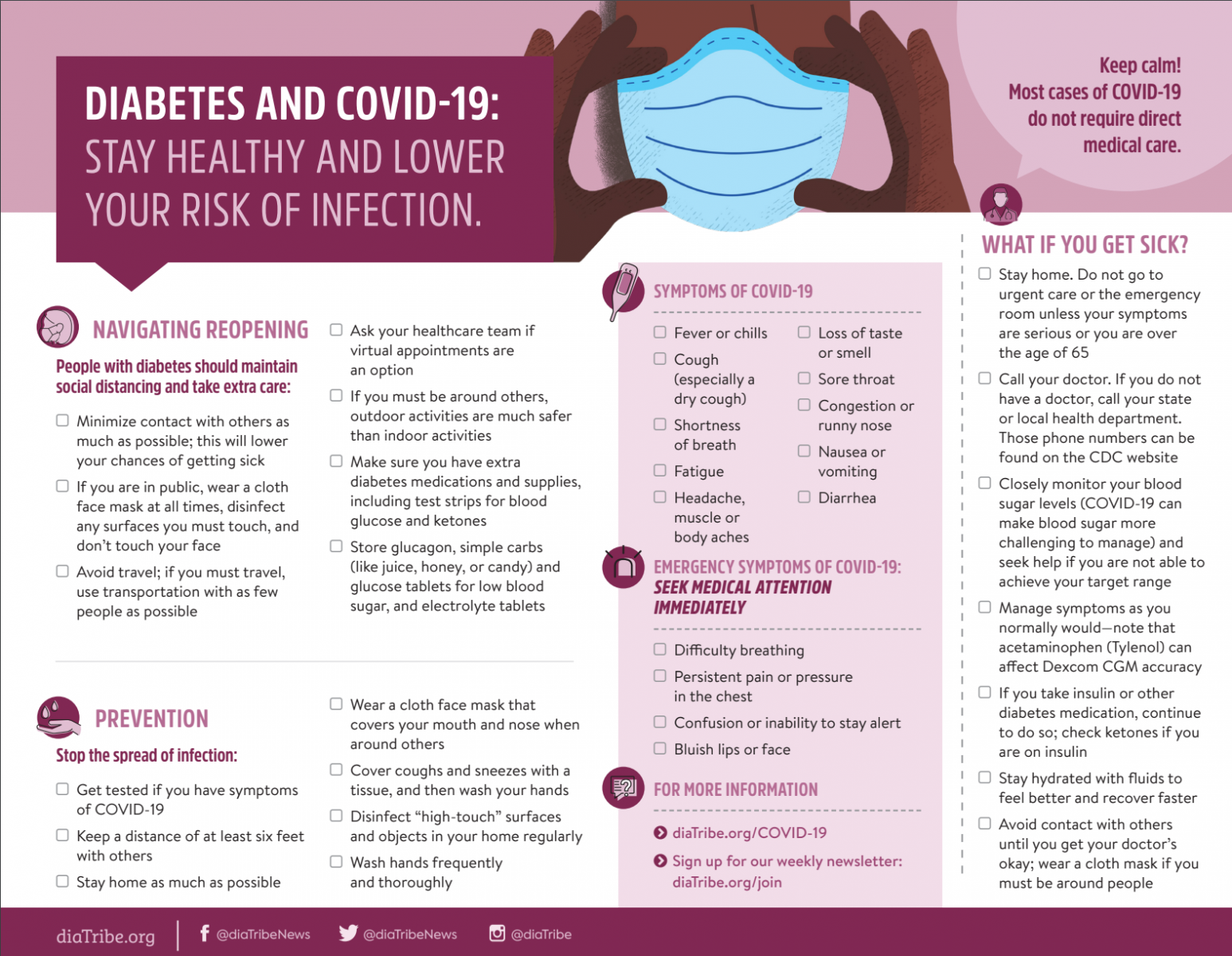The Latest on COVID: Staying Safe as The Pandemic Surges
By Eliza Skoler
 By Eliza Skoler
By Eliza Skoler
As COVID restrictions and recommendations shift, what do we know about staying safe with diabetes? How can we protect others and make careful decisions about risk?
As the pandemic continues to unfold, states and countries are leading their own initiatives to reduce infection rates and keep people safe. This means that people around the world are experiencing different stages of caution, risk, and safety. As we navigate the uncertainty of conflicting messages and daily updates to guidelines and recommendations, everyone – with or without diabetes – can do some things to keep themselves and others as safe as possible. In this article, we’ll look at the latest scientific recommendations to discuss what we know about preventing serious COVID-19 infections.
View our new COVID and diabetes infographic here. Click to read our first COVID reopening article, “COVID Phase 2: Diabetes Care During Reopening,” or check out more of our articles on COVID-19. You can also find the official reopening plan for your US state here.
On July 17, the CDC updated its recommendations for people who are at higher risk for severe coronavirus infection. People with type 2 diabetes have increased risk for severe illness, while people with type 1 diabetes may have increased risk. If you have diabetes, the best thing you can do to prevent severe COVID infection is avoid contact with other people as much as possible.
Click to jump down to a section:
-
Protect yourself in public: wear a mask and wear it properly
-
Navigating reopening: make careful decisions and evaluate your risk
Stay at home as much as possible to avoid contact with other people
Coronavirus is spread through contact with infected people. This means that by avoiding public spaces and people who do not live with you, you can dramatically reduce your chances of infection. We know that not everyone is able to stay home – if you are an essential worker, thank you for the work you are doing. Please be as careful as possible and see below for information on protecting yourself outside the home.
COVID-19 is primarily spread through the droplets that come out of an infected person’s mouth or nose when they talk, breath, cough, sneeze, laugh, or holler. The virus is carried through these small droplets. Anyone close by can be infected by the virus if the droplets enter their mouth, nose, or eyes.
-
Droplets can also land on surfaces (like door handles or food at the grocery store) and infect someone who touches a contaminated surface and then touches their face.
-
The World Health Organization acknowledged in July that COVID-19 may be spread invisibly through the air. Many scientists agree that tiny droplets can stay in the air for an extended period of time after they are released, which means COVID-19 could be considered an airborne virus, increasing its danger. This provides even more reason to stay home.
Protect yourself if you are outside your home
-
Social distance by staying at least six feet away from other people.
-
Wear a cloth face covering when around other people in public. Your mask should full cover your mouth and nose and fit snugly against your face. See below for more tips on wearing and cleaning your face mask.
-
Wash your hands often with soap and water for at least 20 seconds; use a hand sanitizer with at least 60% alcohol when you don’t have access to soap and water.
-
Avoid touching your eyes, nose, and mouth.
-
Avoid close contact with people who are sick, even in your home.
-
Cover coughs and sneezes. Do not remove your mask to cough, sneeze, or talk to others.
 Many people with coronavirus may not show symptoms or know that they are carrying the virus; however, even those without symptoms can still spread it to other people. Cloth face masks are meant to protect people around you if you are already infected (as shown in the image on the right; source: CDC). Studies show that masks are extremely effective: the more people wear masks in public, the less the virus is passed.
Many people with coronavirus may not show symptoms or know that they are carrying the virus; however, even those without symptoms can still spread it to other people. Cloth face masks are meant to protect people around you if you are already infected (as shown in the image on the right; source: CDC). Studies show that masks are extremely effective: the more people wear masks in public, the less the virus is passed.
Here are some resources on cloth face masks:
-
Read the latest from the CDC about cloth face masks, including how to effectively wear your mask to protect yourself and others. See image below to understand this (source: CDC).
-
View an infographic on how to properly wear a face mask from Johns Hopkins Medicine, or learn how to clean and re-use your mask.

Understand why face masks work to stop the spread of COVID-19 from the University of California San Francisco.
-
Read how face mask requirements in parts of the US have reduced coronavirus cases from the journal Health Affairs.
-
The Institute for Health Metrics and Evaluation predicts that 33,000 deaths are preventable in the United States by October, if 95% of people wear masks in public.
As things reopen, make careful decisions
For many people, the hardest part about removing or lessening restrictions is that it can feel “safe” to go back to our pre-pandemic activities. To make the problem even more challenging, even though it’s not completely safe yet, many people are tired of social distancing and staying at home, and the social isolation has taken its toll on many.
According to the CDC, “the more people you interact with, the more closely you interact with them, and the longer that interaction, the higher the risk of COVID-19 spread.” While the pandemic is still raging, here are some ways to be careful if you will be seeing people.
-
See people outside, rather than inside
Because COVID-19 is spread through the air, it is much easier to spread the virus indoors than outdoors given that wind circulation and open space outside are far greater. This means that closed, small, indoor spaces are the most dangerous places to interact with other people. If you or someone you live with has diabetes, avoid seeing others indoors. Instead, consider seeing people outside, where you have more space to remain distant and the breeze complicates the transmission of droplets.
-
If you must see family or friends indoors, open windows or doors to create air flow. Find an indoor space that is large, so that you can stay far apart.
-
Wear cloth face coverings, even at socially distant gatherings.
-
Wash your hands often (or use hand sanitizer) and don’t touch shared surfaces.
-
Read more about the safety of outdoor gatherings from the New York Times.
-
Avoid travel
The CDC continues to recommend that people avoid travel, if possible, because traveling exposes you to many other people who may be infected. This is especially important for people with increased risk; if you have diabetes, or you are considering visiting someone with diabetes, travel can pose a high risk for serious coronavirus infection.
-
While traveling in personal vehicles carries the least risk of COVID-19 infection, activities such as road trips can still expose you to the virus at rest stops, gas stations, and other places where you may stop.
-
Learn more about travel considerations from diaTribe and from the CDC.
-
Given the uncertainty of travel restrictions, if you travel you may run the risk of not being allowed to return home.
-
If you haven’t already, ask your healthcare team if you can try telehealth appointments
Going to a clinic, medical office, or hospital can expose you to people who have COVID-19. Many healthcare teams offer telemedicine appointments so that you can discuss your diabetes management without coming into contact with other people. Ask your healthcare team whether it is safe and important for you to visit the clinic for regular diabetes management.
-
diaTribe has many resources on telehealth for people with diabetes: click to read about preparing for telemedicine appointments or how to upload your blood glucose data, or watch our video on telemedicine during COVID-19.
-
For emergency situations, contact your healthcare team immediately to see if you should visit the emergency room.
-
Learn more about coordinating your care during COVID from Know Diabetes By Heart.
-
Stay as healthy as possible
For people with diabetes, it is more important than ever to carefully manage your blood glucose levels. Keeping your blood glucose levels stable will keep your body healthy and ready to fight off an infection.
-
Continue to take your medication, as directed by your healthcare professional.
-
Keep extra medication and diabetes supplies at home, as well as supplies for low blood sugar events.
-
If you find that your blood sugar levels are not within your target range or you are not meeting your time in range goals, ask your healthcare team if there are any additional interventions you might try. If you don’t yet have access to a continuous glucose monitor (CGM), ask if you can try professional CGM.
-
Exercise regularly and eat healthy food; check out our recipes for “Eating Well and Staying Safe During COVID-19.”
-
View our new infographic on staying safe with diabetes during the pandemic.
If you show symptoms or begin to feel unwell, get tested for COVID-19
Symptoms of COVID-19 can appear up to 14 days after you have been infected with the virus. According to the CDC, these are the symptoms to watch out for:
-
Fever or chills
-
Cough
-
Shortness of breath or difficulty breathing
-
Tiredness
-
Muscle ache, headache, or body aches
-
New loss of taste or smell
-
Sore throat
-
Congestion or runny nose
-
Nausea or vomiting
-
Diarrhea
If you have any of these symptoms or are not feeling well, stay away from others, contact your healthcare professional, and get tested for COVID-19. Find free testing sites in your state here. It is important to note that you may experience other symptoms of COVID-19 that are not listed above, or even no symptoms at all.
We know that people with diabetes face more serious outcomes of COVID-19 infection. If you, or someone close to you, has diabetes, it’s even more important to be careful in this pandemic. The best thing you can do to protect yourself and those around you is stay home as much as possible and wear a face mask (appropriately!) when you’re out in public.









